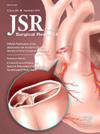开腹腹股沟血管手术 30 天评分风险计算器的开发与验证:乔治-华盛顿腹股沟评分。
IF 1.8
3区 医学
Q2 SURGERY
引用次数: 0
摘要
背景:开腹腹股沟血管手术是治疗外周动脉疾病的重要手段。鉴于其固有的风险和不同患者的情况,需要风险评估工具。本研究旨在为接受腹股沟开放式血管手术的患者开发一种 30 天评分风险计算器:2005年至2021年期间,在美国外科学院国家外科质量改进计划数据库中确定了接受开腹腹股沟血管手术的患者,包括主动脉股动脉、腋股动脉、股动脉、髂股动脉、股动脉-腘动脉、股动脉-胫动脉搭桥术以及血栓内膜切除术。患者被随机抽样分为实验组(2/3)和验证组(1/3)。乔治-华盛顿(GW)腹股沟评分是一种加权评分系统,通过沙利文方法对术前风险变量进行多变量回归,得出 30 天死亡率。GW 腹股沟评分经过了内部和外部验证。此外,还评估了 GW 腹股沟评分对 30 天内主要手术并发症的有效性:结果:共分析了 129424 名患者,其中 86715 人被分配到实验组,42709 人被分配到验证组。GW 腹股沟评分的计算方法如下:主动脉双股旁路(2 分)、腋股旁路(1 分)、年龄(75 岁以上,2 分;65-75 岁,1 分)、播散性癌症(2 分)、急诊(1 分)、美国麻醉学会评分 4 或 5(1 分)、透析(1 分)和术前败血症(1 分)。GW 腹股沟评分具有很强的区分度(c 统计量 = 0.794,95% CI = 0.786-0.803)和校准性(Brier 评分 = 0.029)。从单个术前变量(c-统计量 = 0.809,95% CI = 0.801-0.818)到评分系统的过渡是成功的,评分的外部验证也得到了证实(c-统计量 = 0.789,95% CI = 0.777-0.801,Brier 评分 = 0.030)。此外,GW腹股沟评分能有效判别主要手术并发症:本研究开发了 GW 腹股沟评分,这是一种简明而全面的 10 点风险计算器。这个经过充分验证的评分对开腹腹股沟血管手术后 30 天的死亡率和主要手术并发症具有很强的判别和预测能力。GW 腹股沟评分可预测潜在的围手术期并发症并指导治疗决策。本文章由计算机程序翻译,如有差异,请以英文原文为准。
Development and Validation of a 30-Day Point-Scoring Risk Calculator for Open Groin Vascular Surgery: The George Washington Groin Score
Background
Open groin vascular surgeries are important in managing peripheral arterial diseases. Given its inherent risks and the diverse patient profiles, there is a need for risk assessment tools. This study aimed to develop a 30-d point-scoring risk calculator for patients undergoing open groin vascular surgeries.
Methods
Patients underwent open groin vascular surgery, including aortobifemoral, axillofemoral, femorofemoral, iliofemoral, femoral-popliteal, and femoral-tibial bypass as well as thromboendarterectomy, were identified in American College of Surgeons National Surgical Quality Improvement Program database from 2005 to 2021. Patients were randomly sampled into experimental (2/3) and validation (1/3) groups. The George Washington (GW) groin score, a weighted point-scoring system, was developed for 30-d mortality from multivariable regression on preoperative risk variables by Sullivan's method. GW groin score was subjected to internal and external validation. Furthermore, the effectiveness of GW groin score was evaluated in 30-d major surgical complications.
Results
A total of 129,424 patients were analyzed, with 86,715 allocated to experimental group and 42,709 to validation group. GW groin score is derived as follows: aortobifemoral bypass (2 points), axillofemoral bypass (1 point), age (>75 y, 2 points; 65-75 y, 1 point), disseminated cancer (2 points), emergent presentation (1 point), American Society of Anesthesiology score 4 or 5 (1 point), dialysis (1 point), and preoperative sepsis (1 point).GW groin score exhibited robust discrimination (c-statistic = 0.794, 95% CI = 0.786-0.803) and calibration (Brier score = 0.029). The transition from individual preoperative variables (c-statistic = 0.809, 95% CI = 0.801-0.818) to the point-scoring system was successful and external validation of the score was confirmed (c-statistic = 0.789, 95% CI = 0.777-0.801, Brier score = 0.030). Furthermore, GW groin score can effectively discriminate major surgical complications.
Conclusions
This study developed GW groin score, a concise and comprehensive 10-point risk calculator. This well-validated score demonstrates robust discriminative and predictive abilities for 30-d mortality and major surgical complications following open groin vascular surgeries. GW groin score can anticipate potential perioperative complications and guide treatment decisions.
求助全文
通过发布文献求助,成功后即可免费获取论文全文。
去求助
来源期刊
CiteScore
3.90
自引率
4.50%
发文量
627
审稿时长
138 days
期刊介绍:
The Journal of Surgical Research: Clinical and Laboratory Investigation publishes original articles concerned with clinical and laboratory investigations relevant to surgical practice and teaching. The journal emphasizes reports of clinical investigations or fundamental research bearing directly on surgical management that will be of general interest to a broad range of surgeons and surgical researchers. The articles presented need not have been the products of surgeons or of surgical laboratories.
The Journal of Surgical Research also features review articles and special articles relating to educational, research, or social issues of interest to the academic surgical community.

 求助内容:
求助内容: 应助结果提醒方式:
应助结果提醒方式:


